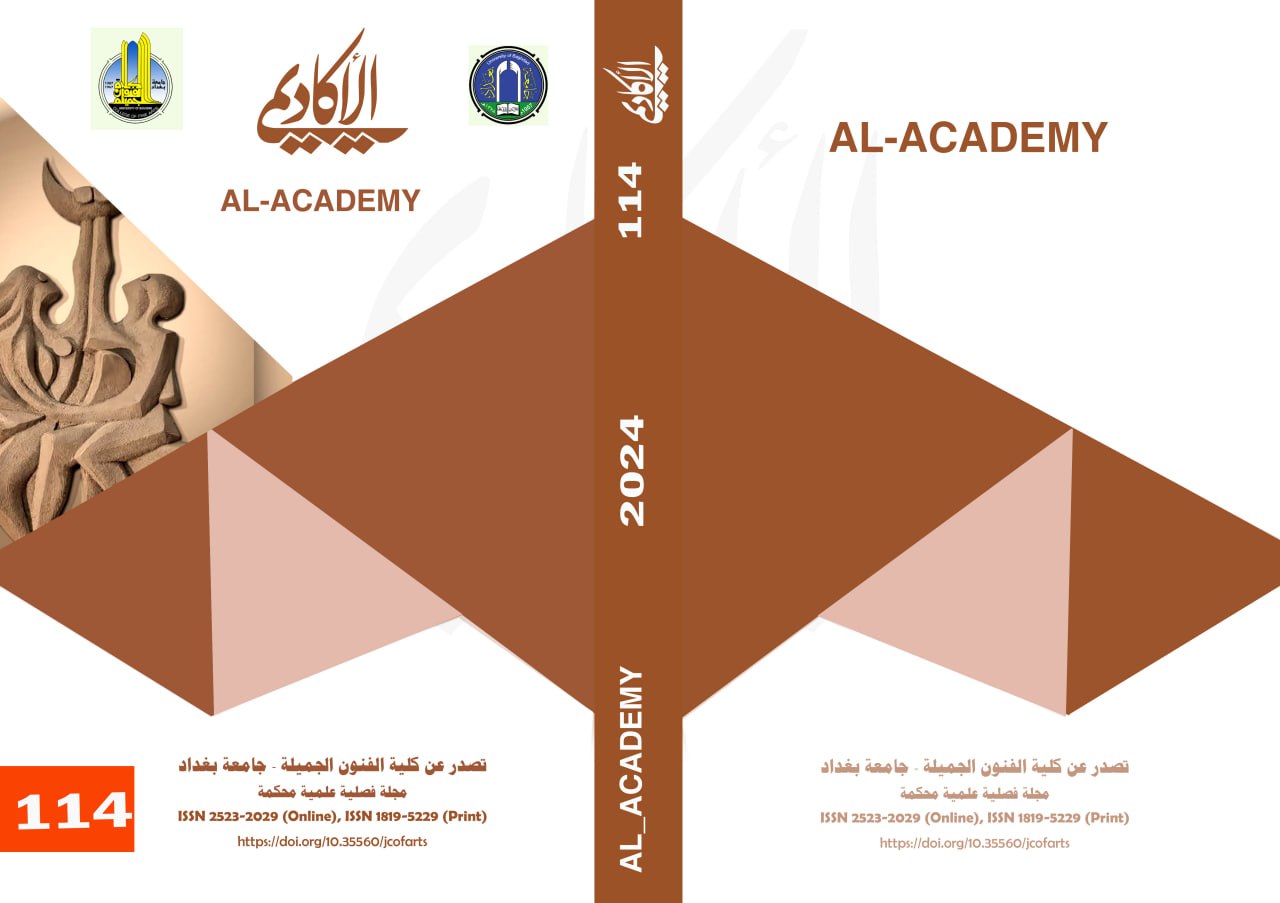The Semantic Shift Of Place In The Cinematic Film (The film “Platform” is an example)
DOI:
https://doi.org/10.35560/jcofarts1513Keywords:
Shift, place, significanceAbstract
This research is concerned with studying the semantic shift of place in the cinematic film, in order to determine the new semantic and aesthetic dimensions that the shift of place from the ordinary adds. This process can only be done by demolishing the usual structure of the elements (or element) of cinematic expression, taking into account giving one of these The elements dominate the rest of the other elements, in order to create a new structure that expresses the content of the topic’s message. The research included the following: Chapter One: The problem of the research, its importance, the need for it, its goal and its limits, mentioning the name of the sample, then defining the terms to provide the procedural definition of the research. Chapter Two: It includes three topics: The first - the concept of displacement and its historical root. Second: The significance of place in literature and art. Third: Representations of the operation of the semantic shift of place in the film. It ended with indicators of the theoretical framework and previous studies. Chapter Three: Research Methodology. Chapter Four (Results and Conclusions): Results:
- The shifting of the significance of the place performed an aesthetic and poetic function, to distance itself from the superficial meaning in order to express the submerged meaning in a way that is consistent with different subject events.
- The lighting served as a supporting element for the dominant element of the place. Displacement must have a dominant expressive element in order for it to perform its metaphorical function.
- The change that occurred in the architecture of the place led to the transformations that occurred in the events of the subject and the psychology of the characters towards the place, which subsequently led to the creation of characters who rebel against the place. The conclusions are:
1- The form of the place is a framing structure for the events of the subject - there is an inseparable relationship between them that ultimately leads to identifying the significance of the characters’ actions.
2- Style is what creates form. Therefore, changing the architecture of the place to suit the theme of the film could indicate the style of its creator.
3- The place in its physical form (sometimes) is a neutral entity that does not acquire the characteristic of familiarity or hostility, but the nature of the event, and the way the characters interact with it, is what gives it its identity. Also, treating the shape of the place (its architecture) in a way that is different from the usual will necessarily lead to a dramatic and aesthetic shift in its significance.
Then the search ended with a list of sources.
References
Al-Adous, Y. a. (1980). Stylistic vision app. Amman: Dar Al-Masirah.
Al-Jurjani, A. b.-S. (1969). Definitions. Beirut: Lebanon Library.
Al-Obaidi, H. M. (1987). The Theory of place in the philosophy of Ibn sina. Baghdad: House of cultural affairs.
Azzam, M. (2005). Poetics of narrative discourse. Damascus: Arab writers union publications.
Bahrawi, H. (1990). The structure of the Narrative Form (Vol. ط1). Beirut: Arab cultural center.
Barthes, R. (1992). Critical articles on theatre. (S. Bashour, Trans.) Damascus: Ministry of culture publications.
Cohen, J. (1986). The structure of poetic language (Vol. 1). (M. El-wali, Trans.) Casablanca: Tobkal publishing house.
Duraid, I. (1980). Language population. Baghdad: Ministry of culture and information.
fayda, a. (1993). Double vision. (S. salah, Trans.) Damascus: Ministry of culture publitions.
Fougali, B. (2008). Time and place in pre-Islamic poetry. Amman: The modern world of books.
Gharaibah, A. F. (2002). Semantic transformations and restructuring of raw material. Baghdad: University of Baghdad, College of Fine Arts, unpublished master’s thesis.
Giraud, p. (1999). Semiotics of social communication. (M. Al-Emari, Ed.) (12).
Hammad, A. A. (1985). Time and place in the story of the old testament. 16(3).
Hussein, D. j. (2007). Semantic research in the book of Sibawayh (Vol. vol1). Amman: Dar dijla.
Ismail, S. (1999, November). Criticism of the concept of dispacement. (23). Maghrib.
Janetti, L. D. (1981). Understanding cinema (1 ed.). (J. Ali, Trans.) Baghdad: Al-Rasheed Publishing House.
Jumaa, I. J. (1990). The narrative space according to jabra Ibrahim habra. العراق: University of Mosul: College of Arts, unpublished doctoral dissertation.
Lahmdani, H. (1991). The structure of the narrative text from the perspective of litrary criticism. Casablanca: Arab cultural center for printing publishing and distribution.
Lotman, Y. (2001). An introduction to the semiotics of film. (N. Al-Debs, Trans.) Damascus: Ministry of culture publications.
Manzur, I. (2005). Lisan al -arab (مج13 ed., Vol. ط4). BEIRUT: Dar sader for printing and publishing.
Marcel Martin. (2017). Cinematic language. (saad Makkawi، المترجمون) Cairo: Egyption general institutio for authoring and puplishing.
Mitry, J. (2000). Psychology and aesthetics of cinema. (A. Aweisheq, Trans.) Damascus: publicatios of the ministry of culture-general organaization for cinema.
Mukhtar Ahmed Omar. (2008). Dictionary of contemporary arabic language (المجلد 1st). Cairo: World of books.
Muslim, T. A. (1989). The problem of place in cinema. Baghdad: University of Baghdad: College of Fine Arts, unpublished master’s thesis.
Muslim, T. A. (2002). Genius image and place. Amman: Al-Shorouk publishing house.
Qassim, S. (2002). The reader and the text (sing and signification) (1 ed.). Cairo: Supreme council of culture.
Rojee, A. (2006). Cinema and the production of meaning. (F. Bashour, Trans.) Damascus: Mininstry of culture publications.
Shaheen, A. (2001). The aesthetics of place in the novels of Jabra Ibrahim Jabra. Bairut: Arab foundation for studies and publishing.
Wais, A. M. (2005). Displacement from the perspective of stylistic studies (Vol. ط1). Lebanon: Majd University Institution for studies publishing and Distribution.














